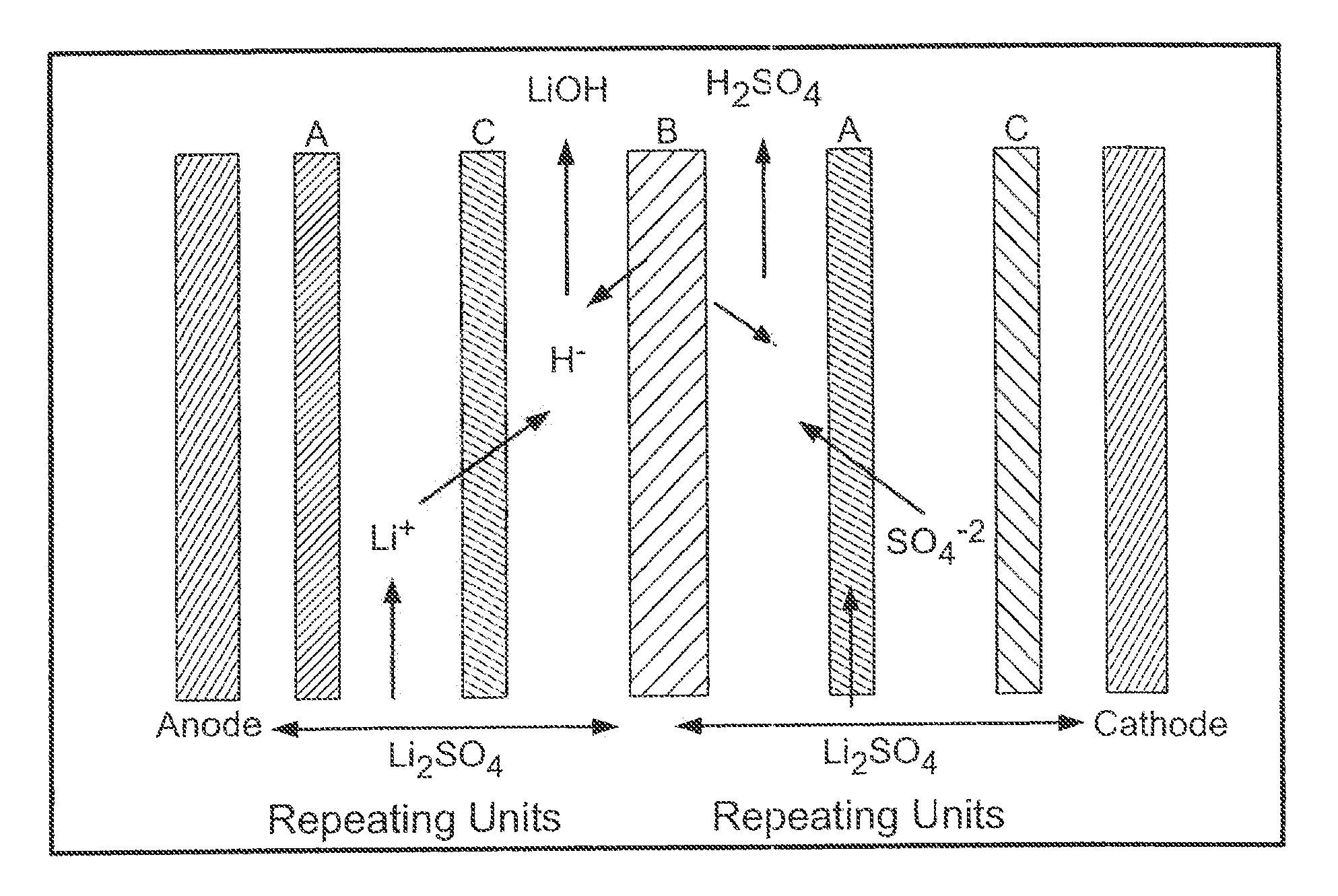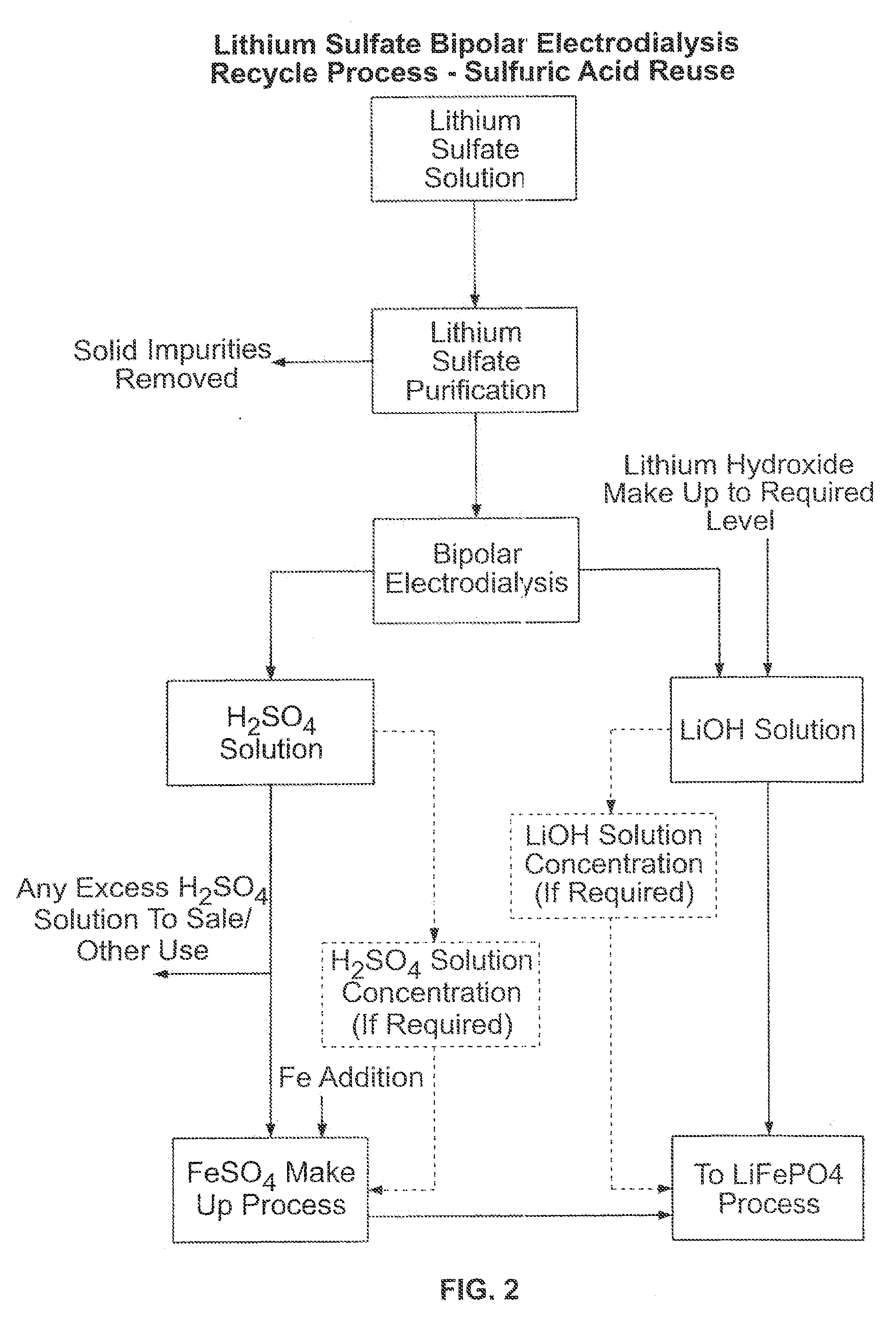Recovery of lithium from aqueous solutions
- Summary
- Abstract
- Description
- Claims
- Application Information
AI Technical Summary
Benefits of technology
Problems solved by technology
Method used
Image
Examples
example 1
[0048]An EUR-2C electrodialysis cell commercially available from Euroduce was modified to include Astom bipolar membranes (BP1) and FuMaTech anion and cation membranes (FAB and FKB respectively). The cell was run with a feed solution that had been pre-treated by pH adjustment to10 to precipitate phosphate and other impurities followed by filtration to remove the precipitates. The pH was then adjusted to pH 3.5 before feeding it into the cell.
[0049]As can be seen from Table 2, the cation membrane generated up to 2.16M LiOH at current efficiencies of approximately 75%. The anion exchange membrane yielded current efficiencies of 40% for a 0.6M H2SO4 product solution. The average current density throughout the run was nearly almost 62 mA / cm2 while operating the cell at a constant voltage of 25V. (This voltage is applied across all seven sets of membranes and the electrode rinse compartment). No solids were seen in the cell in this short term operation, indicating that the pretreatment a...
example 2-5
[0051]Example 2 through 5 were all run with Astom membranes (ACM, CMB and BPD. Examples 2 and 3 were short term experiments using lithium sulfate feed solutions that had been pretreated to pH 10 as described previously. Both examples yielded acid and base current efficiencies close to 60% and maintained good current densities over the short term indicating that the pretreatment improved results compared to prior runs. Example 4 was an overnight experiment run with the same conditions and showed a marked drop in current density, probably due to membrane fouling with phosphate or other precipitates.
[0052]FIG. 5 shows the current density for all three runs. After 1250 minutes the cell was paused and the pumps turned off to allow sampling. Upon restarting the system the current density recovered dramatically indicating that the drop in current was due to small amounts of precipitate that were subsequently washed out of the cell.
[0053]Since the pretreatment at pH 10 seemed to leave some ...
examples 6-10
[0056]In Example 6-10 the Eurodia EUR-2C electrodialysis cell was used to demonstrate the feasibility of a three compartment salt splitting of lithium sulfate. The cell was assembled with seven sets of cation, anion and bipolar membranes configured as shown in FIG. 4. Each membrane has an active area of 0.02 m2.
[0057]It is believed lithium phosphate which is formed in high pH regions adjacent to the cation membrane due to back migration of hydroxide ion is primarily responsible for membrane fouling when it occurs. Pretreatment of the feed solution to remove phosphate and other impurities by raising the pH to 11 precipitates most of these salts and yields improved results compared to adjustment to a pH of only 10.
[0058]Example 9 is representative and is described in detail below. A 1M lithium sulfate starting solution was pretreated to remove insoluble phosphate salts by raising the pH to 11 with 4M LiOH at a ratio of approximately 1L of LiOH to 60L of 1M Li2SO4. The treated lithium ...
PUM
| Property | Measurement | Unit |
|---|---|---|
| Density | aaaaa | aaaaa |
| Density | aaaaa | aaaaa |
| Density | aaaaa | aaaaa |
Abstract
Description
Claims
Application Information
 Login to View More
Login to View More - R&D
- Intellectual Property
- Life Sciences
- Materials
- Tech Scout
- Unparalleled Data Quality
- Higher Quality Content
- 60% Fewer Hallucinations
Browse by: Latest US Patents, China's latest patents, Technical Efficacy Thesaurus, Application Domain, Technology Topic, Popular Technical Reports.
© 2025 PatSnap. All rights reserved.Legal|Privacy policy|Modern Slavery Act Transparency Statement|Sitemap|About US| Contact US: help@patsnap.com



